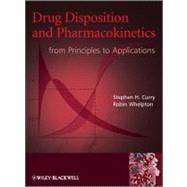
Note: Supplemental materials are not guaranteed with Rental or Used book purchases.
Purchase Benefits
Looking to rent a book? Rent Drug Disposition and Pharmacokinetics From Principles to Applications [ISBN: 9780470684467] for the semester, quarter, and short term or search our site for other textbooks by Curry, Stephen H.; Whelpton, Robin. Renting a textbook can save you up to 90% from the cost of buying.
Stephen H. Curry is an independent consultant, teacher and writer. With extensive experience of academia and the pharmaceutical industry, he is Professor of Pharmacology and Physiology at the University of Rochester, having held appointments at the University of London, the University of Florida, and with Fisons and AstraZeneca. He has written 4 books and over 150 publications in scientific journals, including prize-winning papers and essays. He was the founding co-editor of the Wiley-Blackwell Journal Biopharmaceutics and Drug Disposition.
Robin Whelpton is a senior lecturer at Queen Mary University of London with over thirty years teaching experience. He has written and contributed to a number of books, including co-authoring the successful Fundamentals of Analytical Toxicology published by Wiley-Blackwell in 2008, and published extensively in scientific and technical journals.
About the Authors.
1 Chemical Introduction: Sources, Classification and Chemical Properties of Drugs.
1.1 Introduction.
1.2 Drug nomenclature and classification.
1.3 Properties of molecules.
1.4 Physicochemical interactions between drugs and other chemicals.
1.5 Law of mass action.
1.6 Ionization.
1.7 Partition coefficients.
1.8 Stereochemistry.
2 Drug Administration and Distribution.
2.1 Introduction.
2.2 Drug transfer across biological membranes.
2.3 Drug administration.
2.4 Drug distribution.
2.5 Plasma protein binding.
2.6 Summary.
3 Drug Elimination.
3.1 Introduction.
3.2 Metabolism.
3.3 Excretion.
4 Elementary Pharmacokinetics.
4.1 Introduction.
4.2 Single-compartment models.
4.3 Non-linear kinetics.
4.4 Relationship between dose, onset and duration of effect.
4.5 Limitations of single-compartment models.
4.6 Summary.
5 More Complex and Model Independent Pharmacokinetic Models.
5.1 Introduction.
5.2 Multiple compartment models.
5.3 Curve fitting and choice of most appropriate model.
5.4 Model independent approaches.
5.5 Population pharmacokinetics.
5.6 Summary.
6 Kinetics of Metabolism and Excretion.
6.1 Introduction.
6.2 Metabolite kinetics.
6.3 Renal excretion.
6.4 Excretion infaeces.
7 Further Consideration of Clearance, and Physiological Modelling.
7.1 Introduction.
7.2 Clearance in vitro (metabolic stability).
7.3 Clearance in vivo.
7.4 Hepatic intrinsic clearance.
7.5 In vitro to in vivo extrapolation.
7.6 Limiting values of clearance.
7.7 Safe and effective use of clearance.
7.8 Physiological modelling.
7.8.1 Practical considerations.
7.9 Inhomogeneity of plasma.
8 Drug Formulation: Bioavailability, Bioequivalence and Controlled-Release Preparations.
8.1 Introduction.
8.2 Dissolution.
8.3 Systemic availability.
8.4 Formulation factors affecting bioavailability.
8.5 Bioequivalence.
8.6 Controlled-release preparations.
8.7 Conclusions.
9 Factors Affecting Plasma Concentrations.
9.1 Introduction.
9.2 Time of administration of dose.
9.3 Food, diet and nutrition.
9.4 Smoking.
9.5 Circadian rhythms.
9.6 Weight and obesity.
9.7 Sex.
9.8 Pregnancy.
9.9 Ambulation, posture and exercise.
10 Pharmacogenetics and Pharmacogenomics.
10.1 Introduction.
10.2 Methods for the study of pharmacogenetics.
10.3 N-Acetyltransferase.
10.4 Plasma cholinesterase.
10.5 Cytochrome P450 polymorphisms.
10.6 Alcohol dehydrogenase and acetaldehyde dehydrogenase.
10.7 Thiopurine methyltransferase.
10.8 Phase 2 enzymes.
10.9 Transporters.
10.10 Pharmacodynamic differences.
11 Developmental Pharmacology and Age-related Phenomena.
11.1 Introduction.
11.2 Scientific and regulatory environment in regard to younger and older patients.
11.3 Terminology.
11.4 Physiological and pharmacokinetic processes.
11.5 Body surface area versus weight.
11.6 Age groups.
11.7 Further examples.
12 Effects of Disease on Drug Disposition.
12.1 Introduction.
12.2 Gastrointestinal disorders and drug absorption.
12.3 Congestive heart failure.
12.4 Liver disease.
12.5 Renal impairment.
12.6 Thyroid disease.
12.7 Summary.
13 Quantitative Pharmacological Relationships.
13.1 Introduction.
13.2 Concentration–effect relationships (dose–response curves).
13.3 The importance of relating dose–effect and time-action studies.
14 Pharmacokinetic/Pharmacodynamic Modelling: Simultaneous Measurement of Concentrations and Effect.
14.1 Introduction.
14.2 PK/PD modelling.
15 Extrapolation from Animals to Human Beings and Translational Science.
15.1 Introduction.
15.2 Allometric scaling.
15.3 Dose-ranging versus microdosing studies.
15.4 Statistical approaches.
15.5 Translational science.
References and further reading.
16 Peptides and Other Biological Molecules.
16.1 Introduction.
16.2 Chemical principles.
16.3 Assay methods.
16.4 Pharmacokinetic processes.
16.5 Plasma kinetics and pharmacodynamics.
16.6 Examples of particular interest.
16.7 Conclusion.
17 Drug Interactions.
17.1 Introduction.
17.2 Terminology.
17.3 Time action considerations.
17.4 Interactions involving drug distribution and metabolism.
17.5 Extent of drug interactions.
17.6 Key examples.
17.7 Further examples and mechanisms of a wide range of drug interactions.
17.8 When are drug interactions important?
17.9 Desirable drug–drug interactions.
17.10 Predicting the risk of future drug interactions with new chemical entities.
18 Drug Metabolism and Pharmacokinetics in Toxicology.
18.1 Introduction.
18.2 Terminology.
18.3 Dose–response and time–action with special reference to toxicology.
18.4 Safety studies in new drug discovery.
18.5 Examples.
19 Drug Monitoring in Therapeutics.
19.1 Introduction.
19.2 General considerations.
19.3 Specific Examples.
19.4 Dose adjustment.
19.5 Summary.
Appendix: Mathematical Concepts and the Trapezoidal Method.
1 Algebra, variables and equations.
2 Indices and powers.
3 Logarithms.
4 Calculus.
4.1 Differentiation.
4.2 Integration.
5 Calculating AUC values: the trapezoidal method.
Acknowledgements.
Index.
The New copy of this book will include any supplemental materials advertised. Please check the title of the book to determine if it should include any access cards, study guides, lab manuals, CDs, etc.
The Used, Rental and eBook copies of this book are not guaranteed to include any supplemental materials. Typically, only the book itself is included. This is true even if the title states it includes any access cards, study guides, lab manuals, CDs, etc.